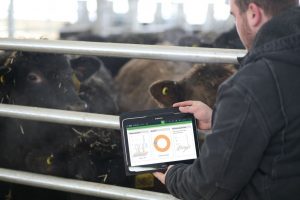At the Canadian Roundtable for Sustainable Beef’s semi-annual meeting, panelists Amie Peck (Canadian Cattlemen’s Association), Michael Young (Canada Beef), John Jamieson (Canadian Centre for Food Integrity), and Clay Holmes (InterCity Packers Meat and Seafood) provided some answers on what goes on in consumers’ heads when they think about beef.
As the food shortages in the early days of the COVID-19 pandemic showed, Canadians turned to their kitchen in droves for feel-good meals. Website clicks on recipes and food prep skyrocketed. While people certainly indulged their sweet tooth, they also cleaned the shelves of beef products. The beef trend, at least, looks like it’s here to stay. How can we capitalize on that?
Overall, Canadians trust the food system, and have a high positive impression of the beef industry. Beef is considered a high-quality product, and most Canadians are still eating at least “some”. Gen Z and millennials are more interested in how food is produced than previous generations, and willing to make purchasing changes based on how they perceive food items are produced. Millennials have a less positive view of the beef industry than previous generations, and feel more social pressure to avoid beef and/or choose what they believe are sustainable protein options. They tend to be skeptical but can be convinced by good information. This creates an opportunity to connect, dispel ideas around negative media content, and provide information to help them make nutritious choices.
Sustainability is a newer and growing point of discussion for the beef industry—but still not as important as cost, quality and safety. We are still in the early-adopter phase, with those consumers who want sustainable options willing to pay for it. After all, the cost of buying into sustainable certifications shouldn’t fall solely on the producers’ shoulders. Importantly, however, many consumers still don’t know that sustainable beef even is an option. And producers aren’t aware of the incentives to embark on this course. We need to communicate the beef message better to each group, and define what sustainability means instead of allowing the plant-based protein sector to drive the story. (As an aside, the Canadian Roundtable for Sustainable Beef won an award for its website on this very topic.) Consumers aren’t looking for perfection, but they do want to see effort and ongoing improvement. This is an opportunity to build more positive perceptions around feedlots, explain what they are and what their role is in the beef value chain.
Producers have the biggest role to play. These are the people consumers want to hear from. These are the people who can say they care about their animals and the environment, and that they are working to limit environmental impacts. We need to put a face on who ranchers are and what their values are.
These messages aren’t being heard well enough. Working on public trust needs to become part of the daily routine of producers to maintain that precious social licence. Some have hit social media incredibly successfully. Unfortunately, these are the pioneers not the norm.



